
Potsdam-Mittelmark is a Kreis (district) in the western part of Brandenburg, Germany. Its neighbouring administrative units are the district of Havelland, the free cities of Brandenburg and Potsdam, the state of Berlin, the district of Teltow-Fläming, and the districts of Wittenberg, Anhalt-Bitterfeld and Jerichower Land in Saxony-Anhalt.
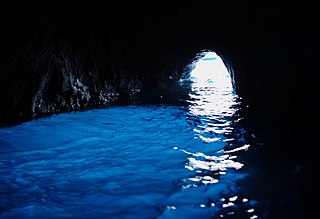
The Blue Grotto is a sea cave on the coast of the island of Capri, southern Italy. Sunlight passing through an underwater cavity and shining through the seawater creates a blue reflection that illuminates the cavern. The cave extends some 50 metres into the cliff at the surface, and is about 150 metres (490 ft) deep, with a sandy bottom.

A grotto is a natural or artificial cave used by humans in both modern times and antiquity, and historically or prehistorically. Naturally occurring grottoes are often small caves near water that are usually flooded or liable to flood at high tide. Sometimes, artificial grottoes are used as garden features. The Grotta Azzurra at Capri and the grotto at Tiberius' Villa Jovis in the Bay of Naples are examples of popular natural seashore grottoes.

The Orangery Palace is a palace located in the Sanssouci Park of Potsdam, Germany. It is also known as the New Orangery on the Klausberg, or just the Orangery. It was built on behest of the "Romantic on the Throne", King Friedrich Wilhelm IV from 1851 to 1864.

The Obelisk entrance constitutes the eastern limit of Sanssouci Park in Potsdam, Germany. Following plans by Georg Wenzeslaus von Knobelsdorff, Frederick the Great ordered in 1747 that this exit from the park be built.

Ss. Peter and Paul Church on Nikolskoë is a Protestant church in the Volkspark Glienecke in Berlin, Germany. It is currently administered by the Evangelical Church of Berlin-Brandenburg-Silesian Upper Lusatia. The church is part of the UNESCO World Heritage Site Palaces and Parks of Potsdam and Berlin.
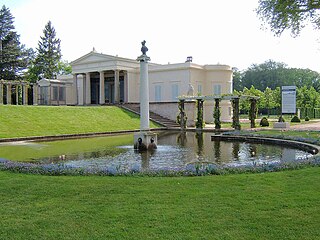
Charlottenhof Palace or Charlottenhof Manor is a former royal palace located southwest of Sanssouci Palace in Sanssouci Park at Potsdam, Germany. It is best known as the summer residence of Crown Prince Frederick William. Today it is maintained by the Prussian Palaces and Gardens Foundation Berlin-Brandenburg.

Glienicke Palace is a historic palace located on the peninsula of Berlin-Wannsee in Germany. It was designed by Karl Friedrich Schinkel around 1825 for Prince Carl of Prussia. Since 1990, Glienicke Palace and the park have been part of the UNESCO World Heritage Site "Palaces and Parks of Potsdam and Berlin" because of their unique contribution to Prussian landscape architecture.

The Ruinenberg is a hill in the Bornstedt borough of Potsdam, located north of Sanssouci Park. In 1748, the Prussian king Frederick the Great had a water tank with a capacity of around 7,600 cubic metres (270,000 cu ft) built on top to supply the Sanssouci water features, and had it decorated with artificial ruins. From 1841 a surrounding landscape garden was laid out at the behest of King Frederick William IV of Prussia, according to plans designed by Peter Joseph Lenné.
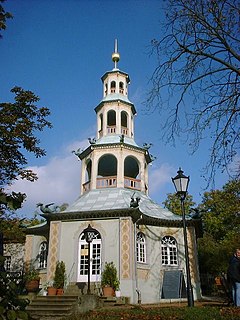
Dragon House is a historical building in Potsdam, Germany, built by King Frederick the Great of Prussia on the southern slope of the Klausberg, which borders the northern edge of Sanssouci Park. It was constructed between 1770 and 1772 in the prevailing Chinoiserie taste of the time, designed to imitate a Chinese pagoda. Carl von Gontard was commissioned to build it. The house served as the residence of the vineyard's vintner.

The New Palace is a palace situated on the western side of the Sanssouci park in Potsdam, Germany. The building was begun in 1763, after the end of the Seven Years' War, under King Friedrich II and was completed in 1769. It is considered to be the last great Prussian Baroque palace.
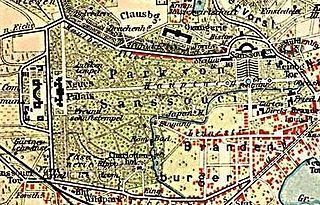
Sanssouci Park is a large park surrounding Sanssouci Palace in Potsdam, Germany, built under Frederick the Great in the mid-1700s. Following the terracing of the vineyard and the completion of the palace, the surroundings were included in the structure. A baroque flower garden with lawns, flower beds, hedges and trees was created. In the hedge quarter 3,000 fruit trees were planted. The greenhouses of the numerous nurseries contained oranges, melons, peaches and bananas. The goddesses Flora and Pomona, who decorate the entrance obelisk at the eastern park exit, were placed there to highlight the connection of a flower, fruit and vegetable garden. Along with the Sanssouci Palace and other neaby palaces and parks, Sanssouci Park was inscribed on the UNESCO World Heritage List in 1990 for its unique architectural unity and testimony to 18th and 19th century landscaping in Europe.

The sculptures in the Schönbrunn Garden at Schönbrunn Palace in Vienna, Austria were created between 1773 and 1780 under the direction of Johann Wilhelm Beyer, a German artist and garden designer. The Great Parterre of Schönbrunn Garden is lined on both sides with 32 over life-size sculptures that represent mythological deities and virtues. The Neptune Fountain at the foot of the Gloriette hill is the crowning monument of the Great Parterre. Other sculptures are distributed throughout the garden and palace forecourt, including fountains and pools. Several sculptors were employed during the execution of these works, among them Johann Baptist Hagenauer.

Leibniz Institute for Astrophysics Potsdam (AIP) is a German research institute. It is the successor of the Berlin Observatory founded in 1700 and of the Astrophysical Observatory Potsdam (AOP) founded in 1874. The latter was the world's first observatory to emphasize explicitly the research area of astrophysics. The AIP was founded in 1992, in a re-structuring following the German reunification.

The Marmorpalais is a former royal residence in Potsdam, near Berlin in Germany, built on the grounds of the extensive Neuer Garten on the shores of the Heiliger See (lake). The palace was commissioned by King Friedrich Wilhelm II and designed in the early Neoclassical style by the architects Carl von Gontard and Carl Gotthard Langhans. The palace remained in use by the Hohenzollern family until the early 20th century. It served as a military museum under communist rule, but has since been restored and is once again open to the public.

The Biosphäre Potsdam is an indoor tropical botanical garden located in the Volkspark Potsdam, a park between the Sanssouci Park and the Neuer Garten Potsdam at Georg-Hermann-Allee 99, Potsdam, Brandenburg, Germany. It is open daily; an admission fee is charged.
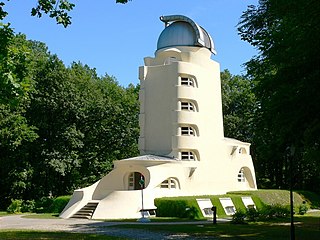
The Albert Einstein Science Park is located on the Telegrafenberg hill in Potsdam, Germany. The park was named after the physicist Albert Einstein. The best known buildings in the park are the Einstein Tower, an astrophysical observatory that was built to perform checks of Einstein's theory of General Relativity; and the Great Refractor of Potsdam, which today belong to the Astrophysical Institute Potsdam. These buildings, along with various astronomical, meteorological, and geophysical observatories were integrated into an English-style country garden.
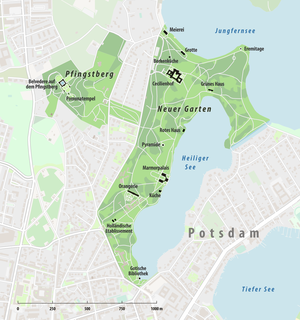
The New Garden in Potsdam is a park of 102.5 hectares located southwest of Berlin, Germany, in northern Potsdam and bordering on the lakes Heiliger See and Jungfernsee. Starting in 1787, Frederick William II of Prussia (1744-1797) arranged to have a new garden laid out on this site, and the design and landscaping was carried out by Johann August Eyserbeck, who had previously worked on the Dessau-Wörlitz Garden Realm.

Babelsberg Palace lies in the eponymous park and quarter of Potsdam, the capital of the German state of Brandenburg, near Berlin. For over 50 years it was the summer residence of Prince William, later German Emperor William I and King of Prussia and his wife, Augusta of the House of Saxe-Weimar-Eisenach, German Empress and Queen of Prussia. Along with the surrounding park and other parks in the area, the Babelsberg Palace was inscribed on the UNESCO World Heritage list in 1990 for its architectural cohesion and its testimony to the power of the Prussian monarchy.




















